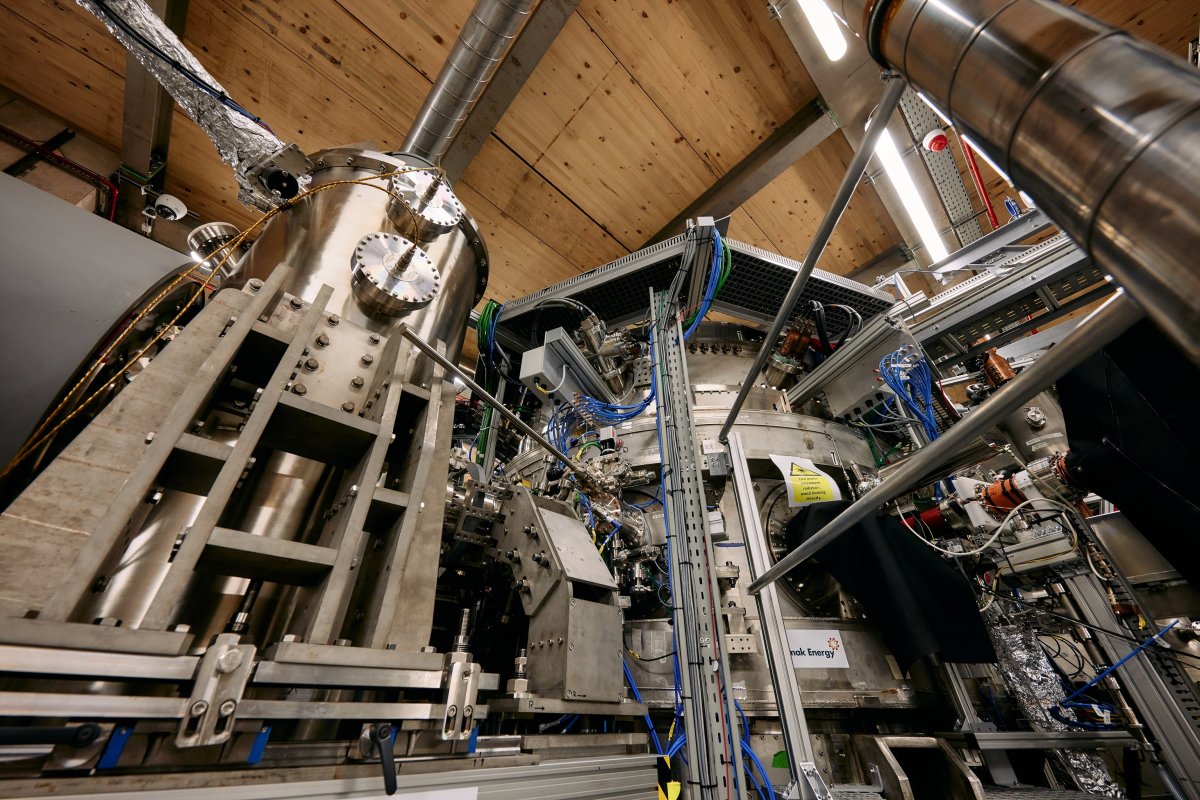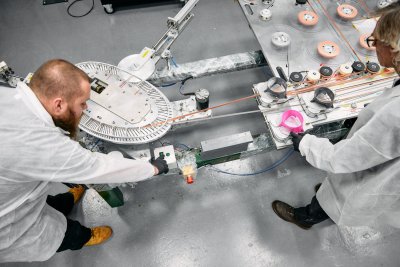What does the inside of a nuclear fusion reactor look like?
"It looks like the future," Stuart White, head of communications at Tokamak Energy, told Newsweek. "A spaceship. It's extremely striking, powerful and exciting. You can't take your eyes off it."
Nuclear fusion is a technology that creates energy in the same way as the sun: it occurs when two atoms are thrust together with such force that they combine into a single, larger atom and release huge amounts of energy in the process.

Unlike nuclear fission—the nuclear reaction that is currently used in the energy sector—fusion does not create radioactive waste. Fusion produces three to four times more energy than fission, as estimated by the U.S. Department of Energy, and does not release carbon dioxide into the atmosphere, like fossil fuels. There is also no risk of nuclear meltdown from this reaction as fusion is a very fragile process that will shut down in seconds if the correct conditions are not maintained.
For decades, nuclear fusion has been touted as the clean energy solution of the distant future but, thanks to advances in the field, this technology might be fully scalable within the next 10 years. One company that aims to be a pioneering entity is Tokamak Energy Ltd, a commercial fusion energy company based in the U.K.
The company uses a machine called a spherical tokamak, a donut-shaped contraption that uses powerful magnets to contain a circular flow of super-hot plasma. Plasma—sometimes referred to as the fourth state of matter, after solids, liquids, and gasses—is basically a soup of negatively charged electrons and positively charged ions that have been ripped apart by the extremely hot temperature of their surroundings. (Your standard atom, such as an oxygen, carbon or hydrogen atom, typically has the same number of protons and electrons to keep it neutrally charged. When an atom loses one or more electrons, it becomes a positively charged ion).
When hydrogen atoms are superheated into a plasma, they become positively charged and repel each other. In the sun, intense gravitational forces create extremely high pressures that overcome this repulsion. But such high pressures are nearly impossible to replicate on Earth. Therefore, we must heat the plasma to an even higher temperature.
"As the temperature gets higher, they're traveling at such high speeds that they overcome those repulsive forces and will actually start to fuse," Chris Kelsall, CEO of Tokamak Energy Ltd, told Newsweek.

This requires temperatures of 180 million degrees Fahrenheit, six times higher than the center of the sun. "When they fuse, [the hydrogen atoms] create an atom of helium and a spare neutron that carries 80 percent of the energy from the reaction, which is ultimately what we harvest," Kelsall said.
The footage above shows the moment that this 180-million-degree-Fahrenheit—or around 100 million degrees Celsius—milestone was reached. The whole process occurs in a matter of milliseconds and only a very small amount of actual fusion takes place. To be fully scalable, fusion power plants would need to run for hours at a time. (Fusion power plants do not yet exist.)
To maintain these extreme conditions, the superhot plasma must be contained in a small area, which is where the tokamak's magnets come in. "Essentially, you've got a system of very large magnets," Tony Langtry, head of engineering at Tokamak Energy, told Newsweek. "The field needed to control the plasma is generated by passing huge currents through some big conductors... As the current goes through these conductors they generate magnetic fields, and since the plasma also has a current, it reacts to, and can be controlled by, these fields."
The tokamak model that is currently in operation at the facility is the ST40, which uses copper magnets to contain the plasma. "Copper is a very good conductor, so when you pass current through it, it creates an electromagnetic field, which contains the plasma," Kelsall said



However, conventional materials like copper have an electrical resistance that counteracts the flow of electricity and converts some of its energy into heat that is essentially wasted. Superconductors, on the other hand, are materials that produce zero resistance and no waste heat under the right conditions.
"We've identified that high temperature superconducting magnets are going to be a game changer in terms of tokamak performance," Kelsall said.
The next tokamak model, the ST80, will use these superconducting materials to create a stronger, more efficient magnetic field for controlling the plasma. Kelsall said that this model would hopefully be ready by 2026/27.
After the ST80, the team will start work on the ST-E1, a commercial pilot plant that will aim to demonstrate the capability of the technology to deliver net electricity into the grid. They hope that this will be complete by the early 2030s.
A major stumbling block for all fusion reactors is that, with such extreme conditions, it is difficult to get more energy out of the reaction than is put in. (This ratio is called Q.) In December 2022, the Lawrence Livermore National Ignition Facility in California—which uses lasers instead of magnets to create fusion—achieved this milestone. "The announcement was very positive for the sector as a whole," Kelsall said. "It is in a different branch of fusion, but it's showing that the sector is moving forward."

However, the Q ratio only considers the energy that is put into the reaction itself; it does not consider all of the energy and power that was required to support the laser system that allows the reaction to happen in the first place.
"Q greater than one is a necessary but not sufficient condition for commercial fusion, and that's across both branches of fusion," Kelsall said.
To be commercially scalable, Q needs to be much greater than one. "For commercial fusion in a magnetic confinement device, that Q needs to be at least high teens or mid 20s," Kelsall said. "So our ST-E1 will be honing in on Q greater than 25."
Without this level of efficiency, the process would not be commercially viable. "Our core philosophy is to achieve a commercial fusion, [that is a] genuinely globally deployable solution," Kelsall said. "We're not about just proving that we can do fusion—that isn't good enough. Our objective is to have a solution that can be low cost, and genuinely deployable in many countries to address climate change and energy security."
The British company has recently been given a grant by the U.S. Department of Energy to test fusion plant materials that will allow the reactors to be self-sufficient while operating. The work will be done in partnership with the Oak Ridge National Laboratory in Tennessee.
Do you have a tip on a science story that Newsweek should be covering? Do you have a question about nuclear fusion? Let us know via science@newsweek.com.
Correction 02/08/23, 12:39 p.m. ET: This article was updated to clarify that an atom has the same number of protons and electrons, not ions and electrons as previously written.
Uncommon Knowledge
Newsweek is committed to challenging conventional wisdom and finding connections in the search for common ground.
Newsweek is committed to challenging conventional wisdom and finding connections in the search for common ground.
About the writer
Pandora Dewan is a Senior Science Reporter at Newsweek based in London, UK. Her focus is reporting on science, health ... Read more
To read how Newsweek uses AI as a newsroom tool, Click here.








